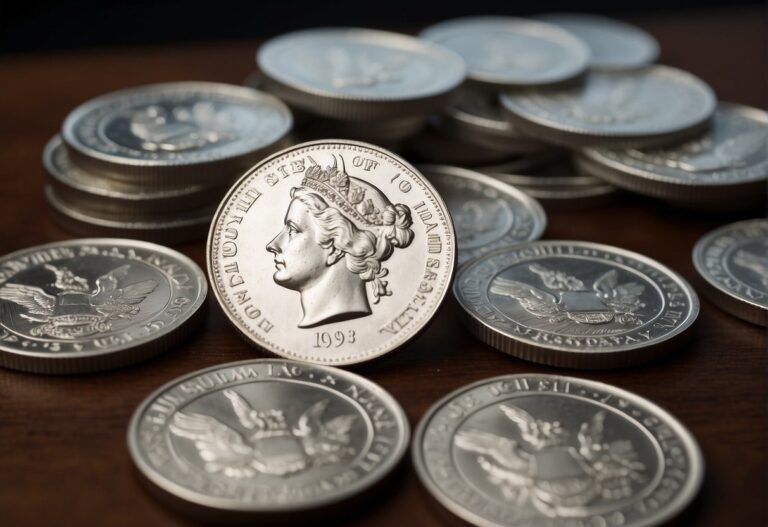A Gold IRA is a specialized type of Individual Retirement Account (IRA) that allows investors to hold physical gold or other approved precious metals as part of their retirement portfolio. Unlike traditional IRAs, typically composed of stocks, bonds, or mutual funds, a Gold IRA is self-directed, giving investors more control over their retirement savings and the flexibility to include certain gold coins and bullion.
Setting up a Gold IRA involves selecting a custodian—usually a bank, brokerage firm, or other IRS-approved entity—that oversees the account and complies with IRS regulations regarding contributions, distributions, and taxation.
Contributing to a Gold IRA involves transferring or rolling over funds from an existing retirement account or making annual contributions within IRS limits. Once funded, the account owner can select from a range of permissible gold investment options.
These investments must adhere to IRS standards regarding purity and form, limiting the inclusion of certain collectibles and metals. The physical gold must be stored in an approved depository that ensures its safety and complies with IRS rules regarding the physical handling and storage of IRA assets.
How Does A Gold IRA Work? Key Takeaways
- Gold IRAs offer a self-directed retirement option focusing on physical gold and other precious metals.
- Establishing a Gold IRA involves setting up a self-directed account with an IRS-approved custodian and adhering to contribution limits and rules.
- Investments made through a Gold IRA require secure storage in IRS-sanctioned depositories to ensure compliance and preservation of assets.
Understanding Gold IRAs
Investing in a Gold IRA allows individuals to diversify their retirement portfolio with a tangible asset. This type of Individual Retirement Account is an alternative to traditional equities and bonds.
What is a Gold IRA?
A Gold IRA, or Gold Individual Retirement Account, is a specialized type of self-directed IRA that enables investors to hold gold as a qualified retirement investment in coins or bullion. This account functions similarly to a Traditional IRA or a Roth IRA, but it has explicitly physical precious metals.
Investors often turn to Gold IRAs to diversify their retirement portfolios, hedge against inflation or economic volatility, and potentially increase the longevity of their savings.
What Are The Types of Gold IRAs?
There are several distinct types of Gold IRAs, each with its respective tax implications and eligibility requirements:
Traditional Gold IRA: This account operates like a Standard IRA, where contributions are typically made pre-tax; earnings then grow tax-deferred, with taxes paid at the time of withdrawal.
Roth Gold IRA: Contrary to the Traditional IRA, Roth IRA contributions are made post-tax, which allows for tax-free growth and withdrawals, given that certain conditions are met.
SEP Gold IRA: A Simplified Employee Pension (SEP) Gold IRA is available to self-employed individuals or small business owners. Similar tax rules apply to Traditional IRAs but with higher contribution limits.
These IRAs adhere to specific IRS regulations regarding purity levels and storage requirements. Investors must thoroughly understand each type and decide which Gold IRA best aligns with their financial goals and tax situations.
The Benefits of Investing in a Gold IRA

Investing in gold can provide investors with stable insurance against economic downturns and serve as a strategic component in a diversified investment portfolio.
Gold IRA Hedge Against Inflation
Gold has historically maintained its value over the long term, making it a strong hedge against inflation. When a currency’s purchasing power declines due to inflation, gold prices often rise, preserving the value of the investor’s holdings.
During periods of high inflation, gold becomes a more attractive investment as it is not directly impacted by the same factors that affect the value of paper currencies.
Diversifying Your Portfolio
Adding gold to an investment portfolio allows investors to diversify their holdings beyond traditional stocks, bonds, and mutual funds. Diversification is a critical strategy in investment as it can reduce overall portfolio risk.
Gold’s price movements are often uncorrelated to those of other asset classes, meaning it does not necessarily follow suit when stocks or bonds decline. This non-correlation can help stabilize a portfolio’s value in volatile markets.
Furthermore, given that gold is a tangible asset, it provides an additional layer of security that paper assets, which can be subject to default or other financial risks, may not offer.
Eligibility and Gold IRA Setup
Investors seeking a diversification strategy for their retirement savings may consider a Gold Individual Retirement Account (IRA), which allows the incorporation of physical precious metals into their retirement portfolio. The following provides details on eligibility and how to establish such an account.
Who Can Open a Gold IRA?
Eligibility for opening a Gold IRA is mainly similar to that of traditional and Roth IRAs. This option is available to any individual with earned income who meets the IRS requirements for IRA contributions.
There are no specific employment or income level prerequisites. An IRA trustee, typically a bank or a broker-dealer, must manage the account to ensure compliance with IRS regulations.
How to Set Up a Gold IRA
Investors must select an appropriate IRA trustee specializing in precious metals to set up a Gold IRA. The steps are as follows:
- Choose a Custodian: Select a reputable IRA trustee to manage the account. Trustees, often banks or brokerage firms, handle documentation, purchases, and storage of physical gold.
- Fund the IRA Account: You can roll over funds from an existing retirement account or directly contribute to the Gold IRA.
- Select the Precious Metals: In coordination with the IRA trustee, purchase eligible gold products such as coins or bullion that meet the IRS purity and fineness standards.
- Storage: The purchased gold must be stored in an IRS-approved depository. Direct possession by the account owner is not allowed.
Each step requires careful consideration to ensure the Gold IRA complies with IRS rules and that the precious metals purchased are of the required purity. The investor’s IRA trustee will typically offer guidance regarding the IRS-approved metals and storage options.
Funding Your Gold IRA
Funding a Gold IRA involves understanding the specific guidelines related to contributions and rollovers. Staying compliant with these rules is crucial to take advantage of the tax benefits available for retirement savings.
Gold IRA Contribution Limits and Rules
The Internal Revenue Service (IRS) sets annual contribution limits for Gold IRAs, aligning with traditional IRA accounts. For 2023, individuals can contribute up to $6,500, with an additional $1,000 “catch-up” contribution allowed for those aged 50 and over.
These contributions can be made with pre-tax or after-tax dollars, depending on whether the account is a Traditional or Roth IRA.
Investors may also fund their Gold IRA through a rollover from an existing retirement account, such as a 401(k) or traditional IRA. If done correctly, this process involves moving funds directly into the Gold IRA, usually without incurring taxes.
It’s worth noting that, as the IRS specifies, only specific gold and precious metals are eligible for funding a Gold IRA. Moreover, earnings within the IRA generally grow tax-deferred, allowing assets to compound over time until withdrawals begin in retirement.
Gold IRA Investment Options
When investing in a Gold IRA, one must choose between different forms of precious metals, such as bullion or coins, and ensure they adhere to the IRS standards for purity and weight.
Choosing IRA-Approved Precious Metals
Investors can usually select from gold, silver, platinum, or palladium for their Gold IRA. Working with a reputable metals dealer is critical to ensuring the metals meet the IRS purity requirements.
For example, gold must be 99.5% pure, silver requires a purity of 99.9%, while platinum and palladium must have a purity of at least 99.95%.
Bullion vs. Coins
Bullion and coins represent the two main options for precious metal investments in a Gold IRA.
Bullion refers to precious metals in bulk form, typically bars or ingots. Investors value bullion for its mass and purity; they can purchase gold bullion in various sizes, often ranging from one ounce to 400 ounces.
Coins: The IRS approves certain coins for inclusion in a Gold IRA. They must be minted by the Treasury Department’s official units, such as the American Eagles and Canadian Maple Leafs. Due to design and rarity, coins bring collectability and legal tender value, often trading at a premium over spot price.
Gold IRA Storage and Custodians
Investing in a Gold IRA necessitates understanding the roles of custodians and the requirements for storing precious metals. The custodian is responsible for acquiring gold and storing it in IRS-approved facilities.
Approved Storage and Custody
Depositories are facilities where physical gold from an IRA is securely stored. These institutions must be IRS-approved to comply with regulatory standards. Choosing the proper custodian is critical since they purchase the gold on behalf of the account holder and arrange delivery to a storage facility specializing in safeguarding precious metals.
IRS Regulations for Storage
Gold IRAs are subject to strict IRS regulations to ensure the safety and proper accounting of the physical gold stored. The gold must be kept in an IRS-approved depository under the custodian’s name. They ensure that the storage facility meets all security and compliance standards set by the IRS, which includes regular reporting and auditing procedures.
The custodian’s role is to oversee these processes, maintain an inventory of assets, and manage transactions per IRS guidelines.
Understanding Fees and Expenses
When managing a Gold IRA, one must be aware of the various fees and expenses that can impact the overall cost of the investment. Transparency in fee structure is essential for investors to make informed financial decisions.
Standard Fees Associated with Gold IRAs
Gold IRAs are subject to different account management and maintenance fees. Here’s a breakdown of the typical fees one might encounter:
- Account Setup Fees: These are one-time fees for opening a new Gold IRA. The cost can vary depending on the provider.
- Annual Maintenance Fees: Custodians charge these fees for administrative services, which also cover record keeping and account statements.
- Storage Fees: Gold IRAs require physical storage for the precious metals, leading to annual storage fees. This cost may be higher depending on whether the storage is segregated or commingled.
- Insurance and Shipping: Although not always labeled as a separate fee, insurance and shipping costs for physical gold contribute to the expenses.
- In some cases, higher fees might be charged if additional services are requested or the investment strategy is more complex.
How to Minimize Gold IRA Costs
To reduce the impact of fees on one’s investment, consider the following strategies:
- Compare Providers: Research different custodians and their fee structures to find competitive pricing.
- Understand Fee Schedules: Some custodians may have scaled fee models based on account value, while others offer flat-rate fees.
- Negotiate Fees: Certain fees, like setup or storage fees, may be negotiable. Engaging in a conversation with the custodian can lead to cost savings.
- Aggregate Investments: Consolidating gold holdings in a single account might result in lower storage fees than multiple accounts.
- Review and Adjust: Regularly assessing one’s Gold IRA can keep costs in check and ensure that one is not paying for unnecessary services.
Managing Your Gold IRA
Investors must be mindful of the rules governing withdrawals and distributions when managing a Gold IRA. Understanding the nuances of these transactions is crucial for maintaining compliance and optimizing one’s retirement strategy.
Making Withdrawals and Distributions
Investors can withdraw from their Gold IRA without penalty at age 59½. Withdrawals must be made by Internal Revenue Service (IRS) regulations, which dictate that physical gold must be sold for cash before distribution. Investors may choose a lump-sum withdrawal or periodic distributions, and these transactions are subject to ordinary income tax.
Planning is recommended for the timely liquidation of precious metals, and coordination with one’s IRA custodian would be great. This is vital because instant liquidity is not as intrinsic to physical gold as it is with more traditional IRA holdings.

Get Matched With A Vetted
GOLD IRA ADVISOR TODAY
Gold IRA Required Minimum Distributions (RMDs)
Gold IRA account holders must start taking Required Minimum Distributions (RMDs) at 72, just like traditional IRAs. RMDs are calculated based on the account holder’s life expectancy and the IRA’s total value.
RMDs pose a unique challenge for gold IRAs since the assets are in physical form. Account holders must appraise their gold at its fair market value at year-end to determine the RMD.
The custodian may then facilitate the sale of the requisite amount of gold to meet the RMD, ensuring tax obligations are satisfied. Failure to take RMDs can result in significant penalties—up to 50% of the amount that should have been withdrawn.
Gold IRA Risks and Considerations
Investing in a Gold IRA involves unique concerns that potential investors should weigh carefully against their financial goals. This section examines the various risks and how to evaluate the balance between potential risks and returns.
Potential Risks of Gold IRA Accounts
Market Volatility: The price of gold can be highly volatile.
While traditionally seen as a haven during financial unrest, its value can fluctuate widely based on market conditions.
- Price Sensitivity: Gold prices are sensitive to global events, which can induce rapid price changes.
- Liquidity Concerns: Although gold is considered a liquid asset, selling physical gold quickly may not yield market value, potentially affecting liquidity during a financial crisis.
Assessing Gold IRA Risk and Return
Evaluating a Gold IRA should be done with careful attention to the balance of risk versus return. Investors need to understand the long-term nature of gold investing and align it with their risk tolerance.
- Long-Term Horizon: Gold is often a long-term investment, which may not suit those seeking short-term gains.
- Diversification: A Gold IRA could diversify a retirement portfolio, which might help manage overall risks.
Understanding and accepting the inherent risks of investing in gold is crucial before one commits to a Gold IRA.

When approaching retirement, individuals often seek to consolidate their retirement savings into more stable and secure assets.
A Gold IRA facilitates this by transferring funds from existing pre-tax or post-tax retirement accounts into precious metals.
This process is known as a Gold IRA rollover, and it can be an appealing option for those looking to diversify their retirement portfolio.
Steps Involved in a Gold IRA Rollover:
- Choose a Custodian: Select an IRS-approved custodian specializing in Gold IRAs.
- Open a Gold IRA Account: Set up a new IRA account with your chosen custodian.
- Fund Your Gold IRA: You can transfer assets from your retirement account or roll over the funds directly or indirectly.
Adhering to IRS guidelines is essential to avoid potential taxes or penalties when assets are rolled over. The IRS has specific rules about rollovers and the types of precious metals allowed in a Gold IRA.
Investors can include various precious metals in their Gold IRA, including gold, silver, platinum, and palladium, provided they meet the IRS fineness standards.
This diversification can safeguard against market volatility as precious metals historically have held long-term value.
Key Considerations:
- Rollover Limitations: Individuals who opt for an indirect rollover to avoid taxes must complete the rollover within 60 days.
- Deposit Caps: Contribution limits for an IRA, including a Gold IRA, apply and may affect the amount you can transfer.
- Tax Implications: Understanding potential taxes or fees beforehand is essential, as improper handling can incur penalties.
It is recommended that investors consult with a financial advisor to fully understand the implications and ensure a seamless transition into a Gold IRA that aligns with their retirement goals.
Gold IRA Frequently Asked Questions
This section provides insights into common inquiries about Gold IRAs, including their structure, regulations, and investment specifics.
What are the advantages and disadvantages of investing in a Gold IRA?
Investing in a Gold IRA offers diversification of retirement assets, a potential hedge against inflation, and exposure to a tangible asset. However, it entails higher storage and insurance fees and usually fluctuates with market uncertainty.
Can I take physical possession of gold in my Gold IRA?
Investors generally cannot take physical possession of gold in their Gold IRA until they reach the age of 59½ without facing taxes and penalties, as the IRS requires the assets to be stored in an approved depository.
What is the primary difference between a traditional IRA and a Gold IRA?
The primary distinction between a traditional IRA and a Gold IRA lies in the asset types held within the account; traditional IRAs hold paper assets, while a Gold IRA holds physical precious metals approved by the IRS.
Are there any specific gold types permitted in a Gold IRA?
Gold IRAs require gold to be of a certain purity, typically .995 or higher, and must be produced by a national government mint or an accredited manufacturer, assayer, or refiner.
How much initial investment is required to establish a Gold IRA?
The financial threshold to open a Gold IRA may vary among providers, but typically, companies require an initial investment ranging from $5,000 to $25,000.
What are the withdrawal rules and penalties for Gold IRAs?
Gold IRAs have withdrawal rules and penalties similar to traditional IRAs. Distributions before age 59½ may incur a 10% early withdrawal penalty. However, there are exceptions, and RMDs (Required Minimum Distributions) must start at age 72.



